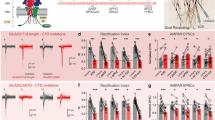Abstract
The reduction in synaptic transmission and plasticity in mice lacking the hippocampus-enriched AMPA receptor (AMPAR) auxiliary subunit TARPγ-8 could be a result of a reduction in AMPAR expression or of the direct action of γ-8. We generated TARPγ-8Δ4 knock-in mice lacking the C-terminal PDZ ligand. We found that synaptic transmission and AMPARs were reduced in the mutant mice, but extrasynaptic AMPAR expression and long-term potentiation (LTP) were unaltered. Our findings suggest that there are distinct TARP-dependent mechanisms for synaptic transmission and LTP.
This is a preview of subscription content, access via your institution
Access options
Subscribe to this journal
Receive 12 print issues and online access
$209.00 per year
only $17.42 per issue
Buy this article
- Purchase on Springer Link
- Instant access to full article PDF
Prices may be subject to local taxes which are calculated during checkout


Similar content being viewed by others
References
Jackson, A.C. & Nicoll, R.A. Neuron 70, 178–199 (2011).
Hashimoto, K. et al. J. Neurosci. 19, 6027–6036 (1999).
Rouach, N. et al. Nat. Neurosci. 8, 1525–1533 (2005).
Fukaya, M. et al. Eur. J. Neurosci. 24, 2177–2190 (2006).
Zamanillo, D. et al. Science 284, 1805–1811 (1999).
Chen, L. et al. Nature 408, 936–943 (2000).
Schnell, E. et al. Proc. Natl. Acad. Sci. USA 99, 13902–13907 (2002).
Milstein, A.D. & Nicoll, R.A. Proc. Natl. Acad. Sci. USA 106, 11348–11351 (2009).
Inamura, M. et al. Neurosci. Res. 55, 45–53 (2006).
Stein, V., House, D.R., Bredt, D.S. & Nicoll, R.A. J. Neurosci. 23, 5503–5506 (2003).
Ehrlich, I. & Malinow, R. J. Neurosci. 24, 916–927 (2004).
Xu, W. et al. Neuron 57, 248–262 (2008).
Kato, A.S. et al. Neuron 68, 1082–1096 (2010).
Opazo, P. et al. Neuron 67, 239–252 (2010).
Acknowledgements
We thank R. Nicoll (University of California, San Francisco) for providing the γ-8−/− mouse. The monoclonal antibody to SynDIG1 was developed by and/or obtained from the UC Davis/US National Institutes of Health NeuroMab. This work is supported by grants from the National Institute of Mental Health (MH077939 to S.T.) and from the US National Institutes of Health (NS050570 and NS065251 to J.A.K.).
Author information
Authors and Affiliations
Contributions
S.T. and J.A.K. conceived the project and wrote the manuscript. A.S., T.E.B., A.S.K. D.S.B. and S.T. performed all of the experiments and analyzed the results. All of the authors contributed to the final version of the manuscript.
Corresponding authors
Ethics declarations
Competing interests
The authors declare no competing financial interests.
Supplementary information
Supplementary Text and Figures
Supplementary Figures 1–7 and Supplementary Methods (PDF 12573 kb)
Rights and permissions
About this article
Cite this article
Sumioka, A., Brown, T., Kato, A. et al. PDZ binding of TARPγ-8 controls synaptic transmission but not synaptic plasticity. Nat Neurosci 14, 1410–1412 (2011). https://doi.org/10.1038/nn.2952
Received:
Accepted:
Published:
Issue Date:
DOI: https://doi.org/10.1038/nn.2952
This article is cited by
-
CaMKII: a central molecular organizer of synaptic plasticity, learning and memory
Nature Reviews Neuroscience (2022)
-
AMPA receptor anchoring at CA1 synapses is determined by N-terminal domain and TARP γ8 interactions
Nature Communications (2021)
-
Molecular Mechanisms of Early and Late LTP
Neurochemical Research (2019)
-
AMPA receptors and their minions: auxiliary proteins in AMPA receptor trafficking
Cellular and Molecular Life Sciences (2019)
-
Activity- and development-dependent down-regulation of TARPγ8 and GluA1 in cultured rat hippocampal neurons
Acta Pharmacologica Sinica (2016)



